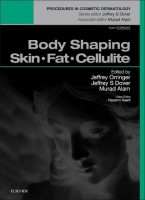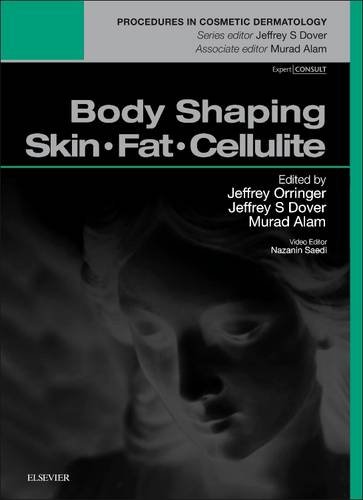 A part of the series: Procedures in Cosmetic Dermatology
A part of the series: Procedures in Cosmetic Dermatology
Editors: Jeffrey Orringer, MD; Jeffrey S. Dover, MD; and Murad Alam, MD
Series Editors: Jeffrey S. Dover, MD; and Murad Alam, MD
Publisher: Elsevier – 143 pages
Book Review by: Nano Khilnani
In recent decades, the desire to look young has spread widely around the world, especially in developed countries. That desire is not just to have clear, clean, and tight skin, but also to have a body that is in great shape, particularly one with “proper” proportions. In other words, a body that is not out of shape.
This means, for women: breasts and buttocks of the “right” size, with a slim midriff. For men, a muscular look, but at the least a chest that is wider than the abdominal area, and tight buttocks. Of course, everything is subjective when it comes to determining what is the right size of any portion of the body.
Often, you see passers-by in public places who are totally out of proportion: obese women whose breasts are too large, abdominal girth that measures 50 inches or more around, and bottoms that require two seats on a bus. The same can be said for men when it comes to their midsections and bottoms. And this does not include people who have so much cellulite in different parts of their body that they would look like sacks of potatoes if they sat down.
As one of a series of books on cosmetic dermatologic procedures, this one deals with solutions in three areas: tightening the skin, reducing weight, and removing excessive cellulite.
Other books in various editions in this group deal with the following solutions to enhance the human body: advanced face lifting, blepharoplasty, body contouring, botulinum toxin, chemical peels, cosmeceuticals, hair transplantation, lasers and lights, liposuction, non-surgical skin tightening and lifting, photodynamic therapy, scar revision, soft tissue augmentation, and treatment of leg veins.
Thirty-five physicians and other experts in dermatology, laser and cosmetic surgery, otolaryngology and related fields – 33 from all over the United States, and one each from Brazil and Germany – authored the 16 chapters of this book that are organized around three sections:
- Skin Tightening
- Skin Laxity
- Lasers and Lights: Skin Tightening
- Radiofrequency Treatment: Skin Tightening
- Macro-focused Ultrasound: Skin Tightening
- Fat Reduction
- Subcutaneous Fat: Anatomy, Physiology, and Treatment Indications
- Cryolipolysis: Fat Reduction
- Radiofrequency Treatment: Fat Reduction
- Ultrasound Treatment: Fat Reduction
- Liposuction, Ultrasound-assisted and Powered: Fat Reduction
- Laser Lipolysis: Fat Reduction
- Injectable Fat-reducing Therapies: Fat Reduction
- Cellulite Reduction
- Cellulite: Anatomy, Etiology, Treatment Indications
- Massage / Mechanical Techniques: Cellulite Reduction
- Lasers and Lights: Cellulite Reduction
- Radiofrequency and Ultrasound: Cellulite Reduction
- Subcision: Cellulite Reduction
To get online access to the contents of this book and other information:
- Login or Sign Up at www.ExpertConsult.com
- Scratch off gray sticker on the inside front cover of this book to get your PIN code
- Enter PIN into the Redeem A Book Code box
- Click on Redeem
- Go to My Library
You can also view several videos online. Here are the online videos available: topics covered in chapters 2, 3, 4, 6, 7, 9, 10, 13, 14, and 16.
The chapters begin with a boxed section entitled Key Messages that consist of points spelling out basic items of knowledge on the subject title. For example, in chapter 1, what is currently known about Skin Laxity, Anatomy, Etiology, and Treatment Indications?
Well, here are some facts revealed in this section that you may or may not have known:
- Skin laxity (looseness) develops with age
- Intrinsic (unseen) and extrinsic (visible) aging causes epidermal thinning, loss of collagen, redistribution of fat – all leading to skin laxity
- Factors such as menopause, rapid weight loss, smoking, ultraviolet light exposure exacerbate skin looseness
Among other features, you will also find the following in this and all chapters throughout the book:
- Pearls: boxes with useful information
- Figures: charts, drawings, etc. for easier understanding of material
- Tables: layouts of nuggets of multiple facts
All in all, this is a valuable book on shaping the human body with work on skin, fat, and cellulite.
Editors:
Jeffrey Orringer, MD is Professor and Chief of the Division of Cosmetic Dermatology at the University of Michigan in Ann Arbor, Michigan.
Jeffrey S. Dover, MD, FRCPC, FRCP is Associate Clinical Professor of Dermatology at Yale University School of Medicine; Clinical Professor at Dartmouth Medical School; Adjunct Associate Professor of Dermatology at Brown Medical School; and Director of SkinCare Physicians in Chestnut Hill, Massachusetts.
Murad Alam, MD, MSCI is Professor of Dermatology, Otolaryngology, and Surgery; and Chief of the Section of Cutaneous and Aesthetic Surgery at Northwestern University in Chicago.
Series Editor: Jeffrey S. Dover, MD, FRCPC, FRCP
Associate Editor: Murad Alam, MD, MSCI







